The Komodo Archipelago
- Patrick Meier

- Jan 5
- 9 min read
Updated: Jan 12
An exceptional scuba diving adventure in Indonesia's Komodo National Park

Whenever people ask me about the most impressive expedition or field trip I experienced so far, I struggle to provide a straight answer. Over the years I have been privileged to embark on some truly amazing adventures. Many of them highly educational, in a sense even formative. There are several places I can't wait to revisit, while I have said my goodbyes to others I know I may never see again in my life. Africa’s wilderness is of course a life-long passion. So is heading out at the crack of dawn to search for pumas in Patagonia, and exploring southern Brazil’s river systems makes my heart jump. The enthralling sound of India’s and southeast Asia’s jungles stay forever with me. And then there are the very rough and tough expeditions, like winter camping in the Canadian High Arctic, or searching for nocturnal wildlife in remote areas of the Sahara Desert. It goes on and on. However, a few weeks ago after processing the photographs I made while scuba diving in the Komodo Archipelago I started thinking that this had been one of my most fascinating trips so far. - Allow me to share this with you!
Off to Singapore
On travels to southeast Asia I enjoy adding two or three nights in Singapore to my itinerary. I find this is a great place to arrive in Asia and shake off jet lag. Malini and I stay at a hotel that has been very dear to me for decades. Instead of a fancy limousine, the concierge arranges a minivan for our airport transfers to accommodate all the diving and photography gear. After check-in and showers, it is all tropical climate, tasty street food suppers, a Singapore Sling or two with samosas, and flexible sleep patterns to adjust to UTC+8.
Stop-over in Singapore
Via Jakarta to Labuan Bajo
While many Indonesian destinations can be reached via Denpasar, my preferred hub for onward domestic travel is Jakarta. At the time of travel, Jakarta was still Indonesia’s Capital, though the Government of Indonesia has recently completed the construction of Nusantara, a new Capital and administration center in eastern Kalimantan, Indonesian Borneo.
Always make sure to include sufficient layover time at Jakarta’s Soekarno-Hatta International Airport (CGK). The Visa on Arrival process may take a bit of patience, and a change of terminal is required to transfer from international flights to domestic connections. There would be a Skytrain linking terminals 1, 2 and 3, but unfortunately this train was constructed in a way that makes using it with more than a small roller case rather difficult. No luggage trollies are permitted on the Skytrain. Instead, I recommend using a taxi to move between terminals. The taxi drivers are very much used to this and happy to help.
The flight from Jakarta CGK to Labuan Bajo LBJ takes about 2½ hrs. Here at the western tip of Flores island is your main gateway to the Komodo Archipelago. Labuan Bajo is a typical Indonesian coastal tourism town, bustling with life and balancing backpacking with super-luxury travel. There are many hotels, resorts, and guest houses, but we wanted to stay in the center near the port and had booked a room at the Meruorah Komodo Hotel on Jalan Soekarno-Hatta. Ideal to stroll out and find cute restaurants and bars catering to all sorts of tastes. At the time of our visit, some highlights were Happy Banana Komodo and Copper Bonnet Bistro & Bar. In peak season all these restaurants require a reservation. I recommend you check current reviews on TripAdvisor or so and book a table by telephone. If you’re interested in art and souvenirs, you may find attractive carvings, crafts, and paintings at various stalls, art galleries, and souvenir shops in town, but make sure to include a visit to Kado Bajo Gift Shop situated right opposite the airport terminal building.
Final approach to Labuan Bajo / Town life / Day outings to Komodo National Park
The diving cruise begins
I have always enjoyed boats. For this cruise we booked a comfy cabin on the ZEN, a 53m phinisi schooner owned and operated by Scubaspa Indonesia. These beautiful two-masted sailing vessels reflect ship-building masterpieces of the Bugis people of South-Sulawesi and are iconic of Indonesia’s maritime tradition. A particular advantage of the ZEN is that diving excursions are conducted using an accompanying boat: a 21m dhoni built in the style of a Maldivian fishing vessel. All the diving equipment, tanks, and filling stations remain on the dhoni, freeing up space for staff and guests on the ZEN. Consequently, the ZEN has a relaxing bar that opens for coffee and pastries at 05:30h, a comfortable dining area, plenty of deck lounge space, and a little spa where professional sport massages are offered.
ZEN, dhoni, beach sunset dinners, and the diving list
Joining a diving cruise meant that we would not be limited to the dive sites that could be reached from a particular resort but could carve out an itinerary and fine-tune our route according to weather and ocean current patterns. If a coastline would be too choppy and windy, we could simply move on, hide behind the next island, and access other dive sites. The crew of the ZEN under Dominik’s guidance has truly perfected this system!
Komodo National Park
Nestled between Sumbawa and Flores in the center of Indonesia’s Sunda islands, Komodo National Park is composed of the three main islands Komodo, Rinca, and Padar, as well as 26 smaller islands. This UNESCO World Heritage Site extends across 1'733km2. Placed on the juncture of two continental plates, Komodo is the geological shatter belt within the Wallacea Biogeographical Region. As part of the coral triangle, the waters around Komodo contain some of the world’s richest marine biodiversity. The most fascinating wild land-inhabitant of Komodo National Park is the Komodo Dragon Varanus komodoensis, the largest living species of lizard.
Partially weather-sheltered by the tall ridges and volcanic peaks of Sumbawa and Flores, Komodo’s climate is much dryer than that of its larger neighbours. The Komodo islands are covered by open grassland and tropical deciduous forests. In combination with its dramatic volcanic rock formations, and black, white, and pink beaches (on many of which Komodo dragons may be observed), the rough hills often present themselves in a Jurassic-Park-like appearance.
Impressions from the Komodo Archipelago
Pulau Sangeang
Our diving cruise would also take us further north-west to Sangeang, one of the most active complex volcanoes of the Lesser Sunda Islands. Its last major eruption on 30 May 2014 produced a massive ash cloud, led to a partial evacuation of the island, and resulted in a temporary suspension of commercial flights in northern Australia as well as between Australia and Indonesia. The island's natural drainage lines and river beds that fall steep into the ocean offer spectacular underwater topography for divers, with black sandy ground separated by coral-covered volcanic rock formations.
Sangeang Island: volcanic marine biodiversity paradise
The waters around Komodo and Pulau Sangeang
If the land- and seascapes above water were spectacular, what followed under water was simply mind blowing. Three to four dives per day between early morning and nightfall offered countless highlights of observations and photographic interaction in this biodiversity hotspot. Besides the outstanding diversity and condition of hard and soft corals, I particularly enjoyed the nudibranchs, octopus and crustacean species, sea urchins, and of course large pelagic fish including huge reef manta rays.
Komodo is known for its strong tidal currents. As everywhere on the planet, tidal movements are strongest around full moon and new moon. Tidal currents between Sumbawa and Flores move south to north during rising tide and in the opposite direction during falling tide. Dive sites on the southern extreme of the archipelago may combine these currents with large swell pressing against rock faces, turning dives into underwater rollercoaster rides. There is not much that can be done from a photography point of view during such dives, instead just hold tight and enjoy the exquisite experience. Some areas of northern Komodo know strong east-to-west currents during rising tide and opposite currents during falling tide, inviting to spectacular drift dives. We enjoyed both The Cauldron and the Golden Passage during falling tide, thus entering in the west and exiting in the east.


Nisa Leme with its notorious downdrafts was not on our itinerary. Instead, we continued from southern Rinca island past Pulau Banta towards the north coast of Sangeang in search of calmer waters, and returned form Sangeang to the north coast of Komodo.
A word of caution: tidal currents around Komodo's small islands flow along, and eventually away from shorelines. If you are relatively new to scuba diving in stronger currents but would like to safely explore dive sites like the ones described here, just make your dive guides aware of this so they can keep an extra eye on you. On the ZEN, each diver is equipped with an active emergency personal locator beacon (PLB) that connects with the ZEN and the dhoni, and eventually all other vessels in an area when it is activated.
Coral paradise
More than 250 species of hard and soft corals can be found in the waters around Komodo. The water temperature here is lower than in other tropical regions. We measured water temperatures of around 23° C. in the southern and 27° C. in the northern dive sites. The strong currents around Komodo provide a continuous flow of nutrients and still prevent excessively warm water temperatures that damage and eventually kill corals and other marine life. We observed and photographed extensive colonies of staghorn, foliose, and table corals, digitate corals, brain corals, Gorgonian sea fans and sea whips, mesmerising xenias, tree corals, bubbles, fire corals, huge sponges, and all in perfectly healthy conditions and full of life.
A tiny glimpse to Komodo's coral biodiversity
Send nudes!
Dr. Terry Gosliner, Senior Curator of Invertebrate Zoology and Geology with California Academy of Sciences is a leading global expert on nudibranchs. While the exact number of globally identified nudibranch species remain uncertain and new species are identified every year, the guide “Nudibranch and Sea Slug Identification – Indo-Pacific” published by Gosliner et. al. illustrates over 2’000 species for this region alone, many of which have been documented in Indonesian waters. Nudibranchs (meaning naked gill) originally descended from shelled molluscs and are often characterised by their vibrant colours. During our time in Komodo we found tiny nudis measuring no more than 5mm in length, and up to the famous Spanish dancers the size of a shoe. –
I can’t wait to explore different parts of the Pacific Ocean in search of these incredible creatures, and will compile a separate blog article on this topic :-)
A selection of nudibranchs photographed in Komodo and Sangeang
Komodo Dragons
Observing a Komodo Dragon (Varanus komodoensis) in the wild has been a dream since the days of my youth. This is the world’s largest living lizard species and male dragons can grow to 3m in length, weighing up to 150kg. The dragons are strictly protected and mainly live on Komodo, Rinca, Padar, and some areas of Flores, and they can sometimes be observed from the diving vessels. No such luck for us during the diving cruise, but I had planned an extra two nights in Labuan Bajo after the diving, and had booked two day-outings to the National Park.
As the park caters to mass tourism tours, it easy to see dragons today, but it can be challenging to photograph them in a meaningful way. The National Park is open from 08:00h – 17:00h and a speed boat cruise from Labuan Bajo to the park entrance will take from 75 to 90 minutes depending on water conditions. A 05:30h departure (if the boat driver shows up in time) would theoretically lead to an arrival at the parks entrance just before sunrise. Special private booking arrangements must be made with a local ranger to be available so early. this would be a good time to photograph dragons on the beach, but unfortunately, this beach is very messy and and even if a dragon can be found near or on the beach, photographers first have to follow the animal or wait until it moves into a position with a background that is free of plastic rubbish that was deposited with the last hight tide.
Then it is possible to head into the park and find dragons. Again, to get a low angle requires a guide and a local ranger. They will stand next or behind the photographer on the ground and warn him/her, once an approaching animal comes close. I made the photographs using various lenses: 14-24mm, 70-200mm, 180-400mm.
While we were there, the big tourist groups started pouring in at around 09:00h. After that, each dragon was surrounded by dozens of people, many of which being part of the Tiktok brigade armed with the latest and greatest selfie-sticks. Such is the current situation there: sadly very messy and overflowing with visitors. However, the potential would be tremendous. It should easily be possible to create a separate zone for small groups and photographers, and of course, with all the parks fees paid by overseas visitors, to clean the beach twice or three times daily. Hopefully future parks management will aim for such improvements.
The most fascinating and impressive Komodo dragon
Please feel free to contact me for further information about equipment for wildlife and nature photography!
Patrick Meier 02.01.2025




































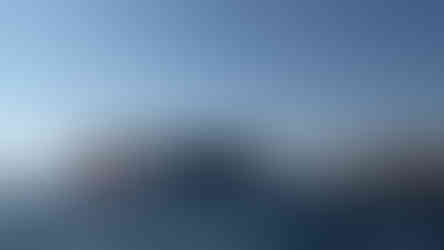












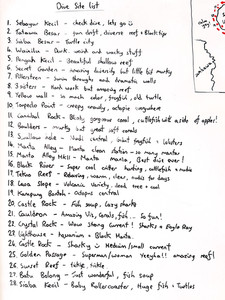






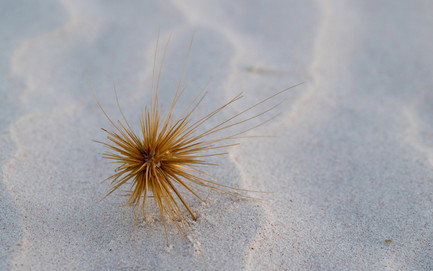




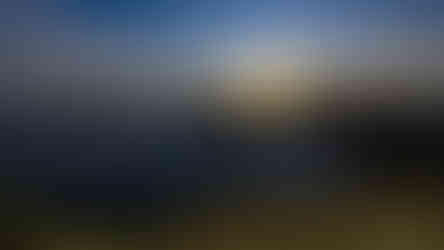























































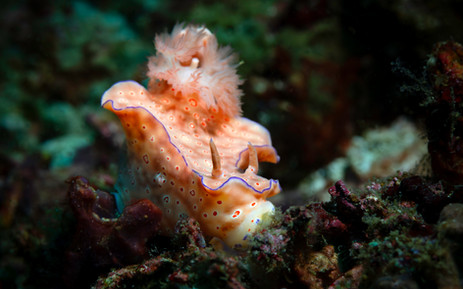







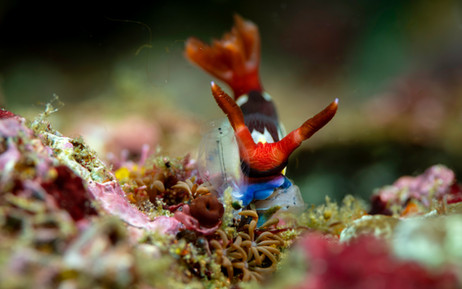











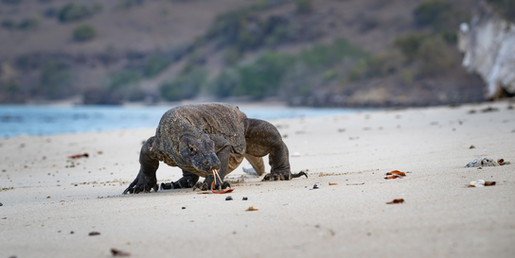







Comments